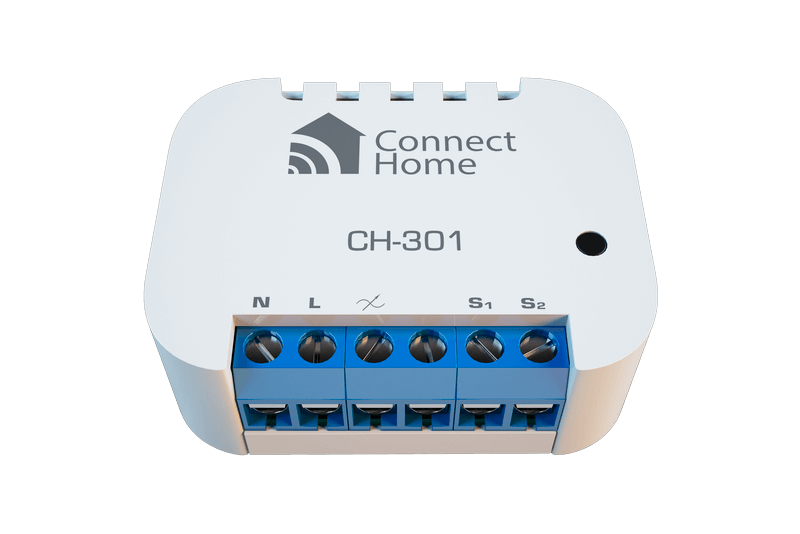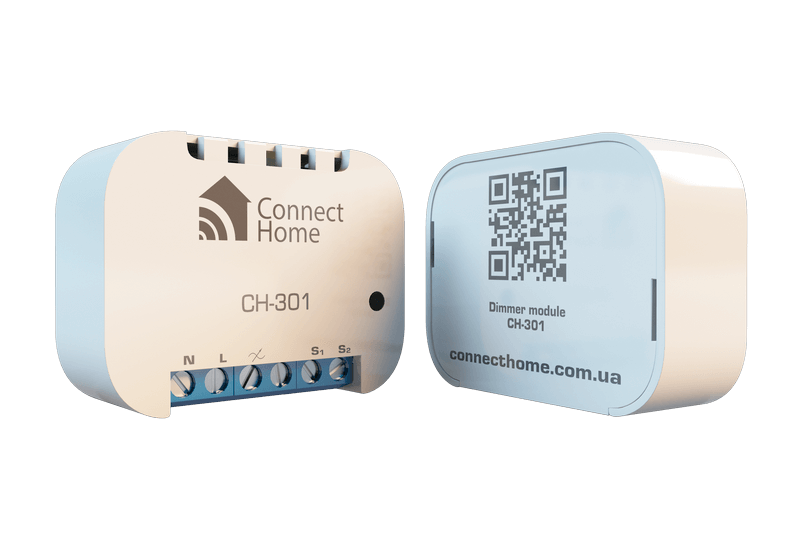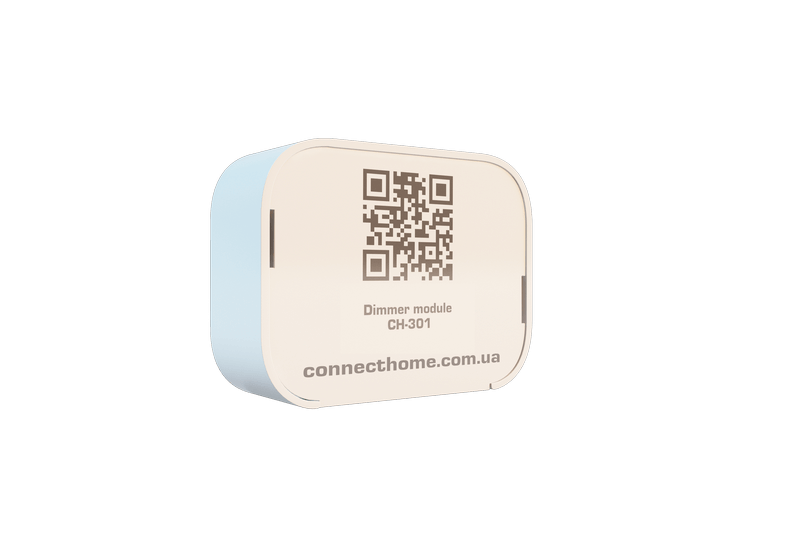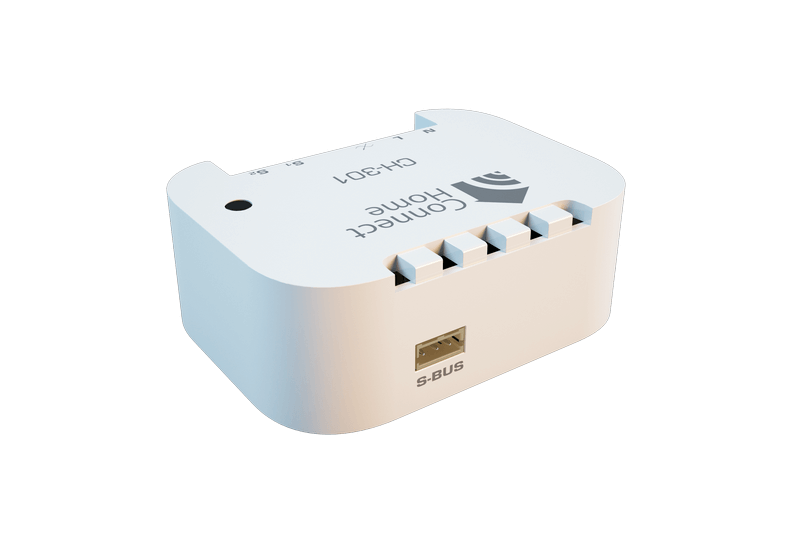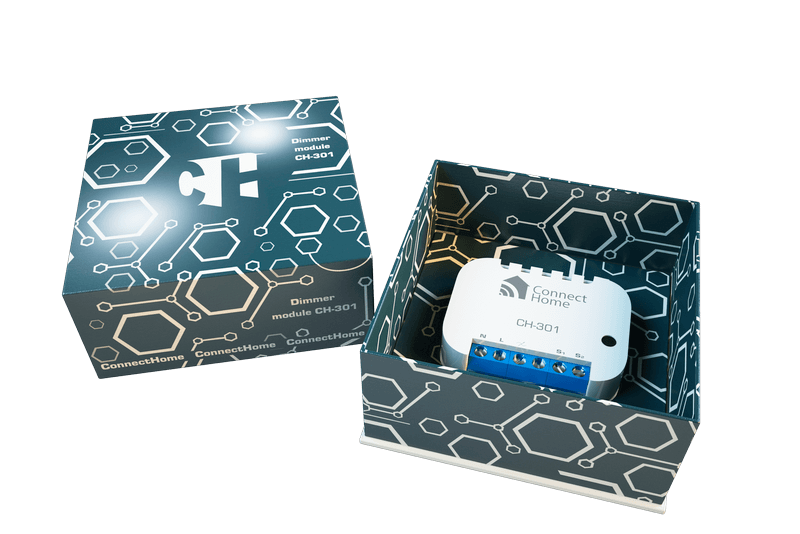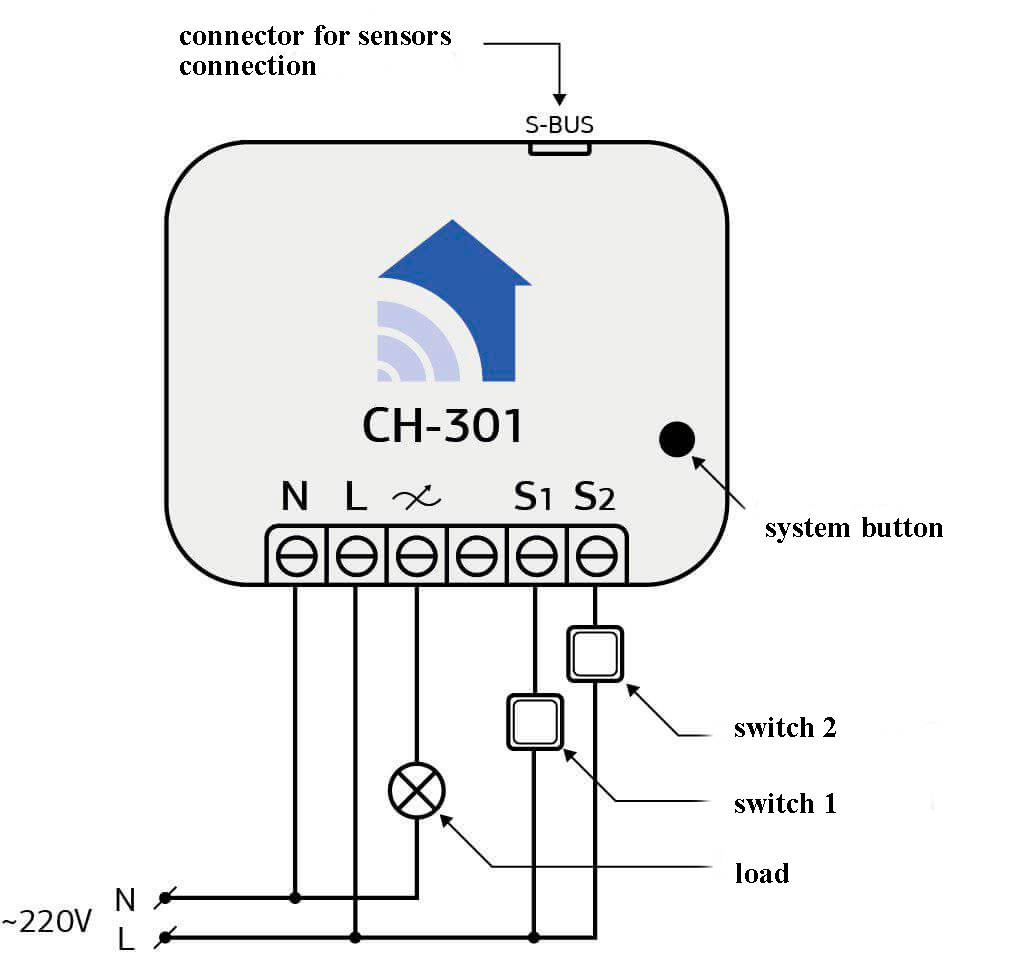Dimmer CH-301 - is a Z-Wave device used to control lighting and dimming of incandescent lamps, halogen lamps, dimmable LED lamps by means of switches connected to it or by means of Z-Wave radio commands. The module is so small that it can be placed even in the installation box behind the switch (Fig. 1).
.png)
Application of the module:
- Lamp brightness control of incandescent lamps
- Dimming control of halogen lamps
- Dimmable LED lamps
Technical Specifications
| Nominal supply voltage | 110 – 250 V AC 50/60 Hz |
| Maximum load capacity | 200W * cos φ |
| Operating temperature | -10 °C to 50 °C |
| Radio signal strength | 2 mW |
| Radio frequency | 868,4 MHz EU; |
| Indoor range | Up to 45 m |
| Operating radius in open space | Up to 75 m |
| Power consumption | < 0.72W |
| Module dimensions | 18*48*37 мм |
| Protection level | IP-30 |
| Possibility to connect S-Bus sensors | Yes |
Attention! It should be noted that the maximum power of the lighting fixture controlled by the dimmer directly depends on its power factor, also cosφ - the ratio of active power to total power. In other words, this value determines the efficiency of the lamp, which part of the total power goes to perform useful work (in our case - lighting), and which part - to maintain the performance of the device itself.
It follows that when calculating the maximum power of the lighting fixtures that will be controlled by the dimmer, you must use the formula: Maximum power = 200W * cosφ
Adding a module to the central controller
To add the module to the network, put the controller into teaching mode (see your controller's manual) and apply power to the electrical network to which the device is connected. The device will be added automatically (NWI). If this does not happen automatically, briefly press the system button located on the top cover of the device three times.
Attention! If you have problems connecting the device to your network, you should go through the procedure of excluding it from the network, and then repeat the procedure of switching it on.
To add removing (excluding) the module from the network, put the controller into the exclusion mode (see the controller's manual) and press the system button three times briefly. Please note, after excluding the device from the network, all the settings you made will be reset to the factory settings
You can also add/remove a device from the Z-Wave network with a switch that is connected to the contact S1. If the switch is monostable (Parameter 15), then adding/removing is done by triple pressing the switch for 2 seconds. If the switch is bistable (Parameter 15), then the addition/removal takes place by successive combinations of switch on/off/on(1-0-1) or off/off/off(0-1-0) within 2 seconds.
Connecting sensors
The CH-101 has two inputs for connecting sensors - binary input S2 and S-Bus input.
Binary input S2 can be used to connect additional buttons/switches that can control other devices in your Z-Wave network. In addition, the S2 pin can be used as an input for a binary sensor, which has only two levels of signal: on/off. To display a binary sensor in the interface, select the value 0 in parameter #9.
You can connect one of ConnectHome's various sensors to the S-Bus input. Sensors are used to assess the environment of your home, such as temperature, relative humidity, and current electrical load power. Sensors are not included in the kit and can be purchased separately if needed.
Sensor list
| Title | Description |
| CH-S01 | temperature sensor |
| CH-S02 | temperature and humidity sensor |
| CH-S06 | power sensor |
In the Z-Wave network, the sensors are displayed as structural units (endpoints) of the CH-101 module. The data are transmitted to the controlling controller by means of Z-Wave radio commands.
In addition, the sensors can control other devices and the module itself. Control should be understood as enabling/disabling the CH-101 module or sending the appropriate command to the devices that are in the communication group of the module when various sensor values are reached. There are link groups for controlling other devices (see Links and Parameters #21-31).
Only one ConnectHome sensor can be connected to the S-Bus input. The sensor must be connected before adding the module to the Z-Wave network. If it is necessary to connect the sensor after connecting the module to the Z-Wave network, first remove it and then add it again after connecting the sensor.
Device control
The module can be controlled locally with a switch connected to it to contact S1 and S2. The switches can be either monostable (return or bell type) or bistable (standard switch with two fixed positions). To select the type of switch, set the corresponding value in Parameters 15 and 16.
Connecting the device
Attention! This device is powered by 230 Volt 50 Hz. Observe the safety rules during installation/dismantling of the device which are described in "DNAP 0.00-1.32-01". Before starting the installation, it is necessary to de-energize the electric network and the protection against accidental energizing of the network must be ensured. All electrical installation work must be carried out by a qualified electrician in accordance with current standards and regulations. If problems arise or if the installer cannot ensure safe operation during the installation, immediately de-energize the unit and the equipment connected to it.
Consider the fact that the module generates a small amount of heat during normal operation. Take measures to ensure normal heat dissipation. Do not install more than one module together in a confined space, and do not allow the module to be enclosed in insulating materials.
Electrical wiring diagrams.
Diagram of connection of Dimmer SN-301
The diagram shows:
- L - phase;
- N is the neutral wire;
- ~ - exit;
- S1 - Contact for switch #1;
- S2 - Contact for switch #2;
Parameters
CH-301 is a so-called "boxed product". This means that you just need to take it out of the box, install it according to the wiring diagram, add it to the network and the device is ready to work. But for your convenience you can fine-tune the device with a number of configuration parameters.
- 0. Ohmic incandescent bulb (halogen bulb);
- 1. Twisted inductive transformer for low-voltage halogen lamps;
- 2. Capacitive twisted transformer for low-voltage halogen lamps;
- 3. (Default) LED lamps and LED lighting fixtures, 230V.
Parameter in which the value for the minimum brightness is specified. Some lamps do not work correctly at the minimum brightness level, in this case you must experimentally select the minimum brightness level that corresponds to the normal operation of the device. Acceptable value is from 0 to 94.
0 (Default).
Parameter that specifies the value for the maximum brightness. The allowable value is from 6 to 99.
99 (Default).
The parameter specifies the time it takes for the light to go from minimum to maximum brightness and vice versa. If you select "0" in the parameter, the switching is instantaneous. Units used in the parameter: 0 - 120.
0 Instantly.
5 (Default).
1 120 - from 1 sec to 120 sec;.
After receiving the power on signal, the device will automatically turn off after a certain amount of time. If you select "0" in the parameter, the auto power off does not work. Units used in the parameter: 1 - 650 (1 = 1 second).
0 (Default).
The parameter allows you to set whether the module reacts to the broadcast commands "Enable All" and "Disable All".
0 (Default) Respond to "Enable All" command, Respond to "Disable All" command.
1 Ignore the "Turn All On" command, Ignore the "Turn All Off" command.
2 Ignore "Turn All On" command, Respond to "Turn All Off" command
3 Respond to the "Turn All On" command, Ignore the "Turn All Off" command.
If you want the device to be restored to its previous state after an electrical failure, select "Restore". If you want the device to be turned off after a power failure, select "Do not restore".
0(Default) Restore;
1 Do not restore. After applying power, the device will be in the "Off" state.
By selecting this option, the unit will automatically maintain the illumination set in Parameter #9, depending on ambient light.
This parameter is only used when the CH-S04.10 motion-light sensor is connected to the dimmer.
The illuminance value to be maintained can be specified in several ways:
- by setting a value in Parameter #9.
- by setting the value with the controller by selecting the value with the slider
- by setting the value with the switch connected to the device.
If you turn on the dimmer when the illuminance is greater than that specified in parameter #9, then the unit will turn on to the last value set and record a new value from the light sensor in parameter #9. Thus, the device will maintain the new value of illuminance.
If you turn on the dimmer when the illumination is less than that specified in parameter #9, then the unit will turn on to the last value set.
0. (Default) Auto adjust is off.
1. Auto Adjustment is on. This setting allows you to adjust the illumination depending on ambient light.
2. Auto brightness adjustment with motion sensor. This value allows you to adjust the brightness depending on external light, as well as to turn on/off the device depending on the readings of the motion sensor.
Parameter that specifies the value (light value - illuminance) that must be maintained in the room.
This parameter is relevant when using the dimmer together with the motion-light sensor CH-S04.10.
Units used in the parameter: 0 - 4000 (1 = 1lx).
— 150 (Default).
The value by which the illuminance set in parameter 9 must change for the device to trigger. The unit of measure used in the parameter: 1 - 255 (1 = 1lc).
10(Default).
Turns on the dimmer, after receiving the command to turn on, not immediately, but after a certain time. If you select the value "0" in the parameter - the switch-on delay does not work. Allowed value is from 1 to 1800 (1 = 1 second).
0.(Default).
After receiving the switch-off signal the load will not switch off immediately, but after a certain time. In Parameter #14 you can select the cases in which the dimmer will ignore the Smart Delay. Acceptable value is 1-1800 (1 = 1 second);
0.(Default).
This option will allow you to configure the "Smart Hold" in more detail.
The module can receive an on/off command from:
- local switches;
- controller (devices from the 1st group of connections);
- other devices using communication;
- of the sensor connected to the module on condition of combining the module with the sensor (Parameter No. 21)
- 0 - Respond to "Smart Hold" (Parameter 13), whichever way the "Off" command is received;
- 1 - (Default) Respond to "Smart-Stop" if a "Shutdown" command is received from:- Devices that are not in the 1st group of links;- Sensors connected to the module.If a shutdown command is received from the local S1 switch or controller, the module will shut down immediately.
- 2 - Respond to "Smart-Stop" if a "Shutdown" command is received from:- Devices that are not in the 1st group of links;- Sensors connected to the module.If a "Shutdown" command is received from a local switch or controller, the load will stop interacting with the sensor and will not shut down until it receives a "Shutdown" command from the local switch or controller.
To measure the number of watts of electricity consumed, enter in this parameter the number of watts consumed by all the luminaires to which the CH-301 module is connected. For example: 9 light sources of 21 watts each, 21*9 = 189 watts. Units used in the parameter: 1 - 5000 (1 = 1W).
Check the number of watts consumed by one luminaire with the lamp manufacturer
0.- The function is disabled (Default)
Operation parameters of pushbuttons/switches
The module has the possibility of connecting one or two switches to it. The first switch can control the module directly, and up to ten devices can be connected to it (using the 2nd group of links). The second switch is used exclusively to control other devices (up to 10 devices) connected to it using the 3rd group of links.
Monostable - for a return-type switch or for a button, each press switches the device to the opposite state.
Bistable - for conventional switches with two fixed On and Off positions.
0. (Default) Monostable - In this mode, each subsequent push of the button switches the device to the opposite state. Monostable switches support the dimmer control function. Pressing and holding the monostable button sends a start dimming command to the dimmer, releasing the button you can select the desired level of illumination;
1. Bistable - each subsequent switch change will change the load state (on/off) regardless of the initial key position;
2. Bistable, fixed position (Option 1) (contacts on the switch closed - load on, open - load off);
Note that if the module receives a command from another device in the network, the load will change its state and must first be returned to the appropriate state to control the breaker.
3. Bistable, fixed position (Option 2). Similar to the previous one, but vice versa (contacts on the switch are closed - load is off, open - load is on).
4. Switch with middle position. A switch with 2 monostable switches, one connected to contact S1 and the other to contact S2. The switch that is connected to contact S1 - turns on and dims the lighting "up" - increases the brightness. The switch that is connected to the contact S2 - turns off and dims the lighting "down" - decreases the brightness.
0. (Default) Monostable - In this mode, each subsequent push of the button switches the device to the opposite state. Monostable switches support the dimmer control function. Pressing and holding the monostable button sends a start dimming command to the dimmer, releasing the button you can select the desired level of illumination;
1. Bistable - each subsequent switch change will change the load state (on/off) regardless of the initial key position;
2. Bistable, fixed position (Option 1) (contacts on the switch closed - load on, open - load off);
Note that if the module receives a command from another device in the network, the load will change its state and must first be returned to the appropriate state to control the breaker.
3. Bistable, fixed position (Option 2). Similar to the previous one, but vice versa (contacts on the switch are closed - load is off, open - load is on).
The parameter goes to the maximum light level after double pressing the switch connected to the contact S1. Sending such a command is only possible in monostable switch mode (Parameter #16 - value 0).
0. The function is disabled;
1. (Default) The function is enabled.
Sensor operating parameters
In the network, sensors are displayed as structural units (endpoints) of the СН-301 module. The sensor that has the lowest serial number in the network is called sensor No. 1, the sensor that has the highest serial number in the network is called sensor No. 2, and so on.
When selecting a value in the parameters, you must take into account the type of sensor to be connected.
The parameter is used to create a fully functional device using the CH-301 module and the sensor connected to it.
0. (Default) Dimmer is not controlled by the sensor;
1. The dimmer is controlled by sensor #1;
2. The dimmer is controlled by sensor #2;
Parameters for sensor #1
The value for multilevel sensors that will be used to turn on devices from the 6th group of connections or directly to the dimmer (if "1" is selected in Parameter 21).
IMPORTANT! When selecting the value, consider the type of sensor to be connected and the magnitude of the measured data.
Available settings are from -60 to 1000;
0 - Default.
The value for multilevel sensors that will be used to turn off devices from the 6th group of connections or directly to the dimmer (when "1" is selected in Parameter 25).
IMPORTANT! When selecting the value, consider the type of sensor to be connected and the magnitude of the measured data.
Available settings are from -60 to 1000;
0 - Default.
The parameter is taken into account when combining the dimmer with one of the sensors or when controlling the sensor with other devices included in the 6th group of connections (Table 2).
0. (Default) Do not respond to on/off values.
1. For multilevel sensors. Enable if the sensor value is less than or equal to the enable value. Switch off if the sensor value is greater than or equal to the switch off value. WARNING The on point cannot be greater than the off point.For binary sensors. Send a command to enable at rest and disable at event.
2. For multilevel sensors. Switch off if the value is less than or equal to the switch off value. Switch on if the value is greater than or equal to the switch-on value. WARNING The switch-off point cannot be greater than the switch-on point. Send a command to turn on when an event occurs and to turn off when no event occurs. For binary sensors. Send a command to turn on when an event occurs and to turn off when at rest.
3. For multilevel sensors. Enable if the value is less than or equal to the enable value For binary sensors. Send command to enable at rest.
4. For multilevel sensors. Turn on if the value is greater than or equal to the enable value.For binary sensors. Send command to turn off at rest.
5. For multilevel sensors. Turn off if the value is greater than or equal to the turn off value For binary sensors. Send a command to turn on when an event occurs.
6. For multilevel sensors. Turn off if the value is less than or equal to the turn off value.For binary sensors. Send a command to turn off when an event occurs.
This parameter is used to adjust the frequency of sending data from the sensors connected to the module. The values will only be sent if they are greater than the value specified in the parameter.Acceptable value (1-100);
Default value depending on the type of sensor connected (temperature 1, humidity 5, illuminance 100 lx, power 50W).
This parameter is used to adjust the frequency of sending data of the sensors connected to the module after a set time.
Allowable value (0-600sec);
0 seconds (Default)
The parameter works if sensor #1 is a temperature sensor, otherwise the parameter is ignored. In some cases of temperature sensor location, the measured values need to be corrected.
0. (Default) Send the actual temperature (further t);
1. t +1°С;
2. t +2°С;
3. t +3°С;
4. t +4°С;
5. t +5°С;
6. t -1°С;
7. t -2°С;
8. t -3°С;
9. t -4°С;
10. t -5°С.
Parameters for sensor #2
The value for multilevel sensors that will be used to turn on devices from the 7th group of connections or directly to the dimmer (when "2" is selected in Parameter 21).
IMPORTANT: When selecting a value, consider the type of sensor to be connected and the magnitude of the measured data.Available settings are from -60 to 1000;
0. - Default.
The value for multilevel sensors that will be used to turn off devices from the 7th group of connections or directly to the dimmer (when "2" is selected in Parameter #21).
IMPORTANT: When selecting a value, consider the type of sensor to be connected and the magnitude of the measured data.Available settings are from -60 to 1000;
0. - Default.
The parameter is taken into account if the load is combined with one of the sensors or if the sensor is controlled by other devices included in the 7th group of connections
0. Do not react to on/off values (Default).
1. For multilevel sensors. Enable if the sensor value is less than or equal to the enable value. Switch off if the sensor value is greater than or equal to the switch off value. WARNING The on point cannot be greater than the off point.For binary sensors. Send a command to enable at rest and disable at event.
2. For multilevel sensors. Switch off if the value is less than or equal to the switch off value. Switch on if the value is greater than or equal to the switch-on value. WARNING The switch-off point cannot be greater than the switch-on point. Send a command to turn on when an event occurs and to turn off when idle.
3. For multilevel sensors. Enable if the value is less than or equal to the enable value For binary sensors. Send command to enable at rest.
4. For multilevel sensors. Turn on if the value is greater than or equal to the enable value.For binary sensors. Send command to turn off at rest.
5. For multilevel sensors. Turn on if the value is greater than or equal to the enable value.For binary sensors. Send command to turn off at rest.
6. For multilevel sensors. Turn off if the value is less than or equal to the turn off value.For binary sensors. Send a command to turn off when an event occurs.
This parameter is used to adjust the frequency of sending data from the sensors connected to the module. The values will only be sent if they are greater than the value specified in the parameter.Acceptable value (1-100);
Default value depending on the type of sensor connected (temperature 1, humidity 5, illuminance 100 lx, power 50 W).
This parameter is used to adjust the frequency of sending data of the sensors connected to the module after a set time.
Allowable value (0-600 seconds);
0 seconds (Default).
If the second sensor is a motion sensor, then you can set its sensitivity. The parameter allows you to configure the sensor to detect the movement of objects of different sizes. For example, if the sensor does not react to small animals (cats, dogs, etc.), but reacts to a person. Valid values are from 1 to 99.
50. (Default)
If the second sensor is a motion sensor, you can set a delay between states in seconds. The delay allows you not to change the sensor reading for a certain period of time. It is used in cases when there is no need to react to the motion instantly. Valid values from 1 to 3600 (1 = 1 second).
0No Delay (Default)
The parameter works if sensor #2 is a temperature sensor, otherwise the parameter is ignored. In some cases of temperature sensor location, the measured values must be corrected.
0 (Default) Send the actual temperature (further t);
1. t +1°С;
2. t +2°С;
3. t +3°С;
4. t +4°С;
5. t +5°С;
6. t -1°С;
7. t -2°С;
8. t -3°С;
9. t -4°С;
10. t -5°С.
Device Connections
Devices can communicate with each other as well as exchange data and other information both with the central controller and directly without the controller. Each event can have its own list of recipients, called an association group. Refer to your controller's user manual to set up the associations.
LINK GROUPS CN-301:
- Group 1 - device (recommended controller), which will receive reports on dimmer status changes. The size of the group is 1 device.
- Group 2 - devices that will receive On/Off command when the switch connected to the contact S1 is pressed. The size of the group is 10 devices.
- Group 3 - devices that will receive the dimming command when holding the switch connected to the S1 contact. The size of the group is 10 devices.
- Group 4 - devices that will receive On/Off command when you press the switch connected to the contact S2. The size of the group is 10 devices.
- Group 5 - devices that will receive the dimming command when holding the switch connected to the S2 contact. The size of the group is 10 devices.
- Group 6 - devices controlled by sensor 1. The group size is 10 devices.
- Group 7 - devices controlled by sensor 2. Group size - 10 devices.
THE LINK GROUPS FOR THE SENSORS CONNECTED TO THE SN-301:
Sensor #1
- Group 1 - device (recommended controller), which will receive reports on changes in the state of the dimmer. Group size - 1 device Association Group "Lifeline".
- Group 2 - devices controlled by sensor 1. The group size is 10 devices.
Sensor #2
- Group 1 - device (recommended controller), which will receive reports on changes in the state of the dimmer. Group size 1 device Association Group "Lifeline"
- Group 2 - devices controlled by sensor 2. Group size - 10 devices.
Manufacturer's warranty.
The warranty period is 1 year from the date of sale. Products that were transported, stored, assembled and operated with violations of the requirements for these products, as well as having mechanical damage - warranty replacement is not subject to the warranty.
Do not use the unit in any way other than that specified in this manual. The manufacturer shall not be liable for any warranty in case of improper use, modification or painting of the device. Immediately after opening the package, be sure to check the device for damage. If there is visible damage, do not connect or use the device.
Briefly about the C-Home system
All C-Home devices use a reliable and completely safe radio channel, on the basis of which the modules are combined with each other in a single network, which allows you to receive and transmit control signals to other devices in the network, using intermediate neighboring nodes.
The C-Home system has the ability to automatically reconstruct data transmission routes, depending on external factors, for example, if there is an obstacle between two neighboring devices, the signal will go through other nodes in the network in range.
C-Home is a two-way network. The devices can not only send control commands, but also wait for confirmation of their delivery and query the current status of the device. If the sending was not successful, the system tries to send the command another way.
The central element of the C-Home network is the Butler, which stores information about the network topology. It allows you to add and remove devices from the network and control all devices remotely. Not only C-Home company devices, but also more than 4,500 devices of various types and manufacturers can be connected to the Butler, which enables the implementation of any home automation tasks.

